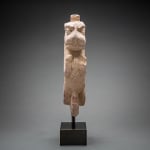Indian Stone Figure of a Lion, 1200 BCE - 1500 CE
Stone
height 61 cm
height 24 in
height 24 in
SF.049
Further images
This sculpture shows a lion standing on its hind legs, with its front legs raised and pointing forwards, baring its claws. This pose creates a sinuous curve in its back,...
This sculpture shows a lion standing on its hind legs, with its front legs raised and pointing forwards, baring its claws. This pose creates a sinuous curve in its back, and gives the sense of the animal being on its guard, ready to combat any threats that might appear. An area of cross-hatching going down the back of its head suggests the presence of a mane, making it likely that this statue represents a lion. There is also a tuft of fur under its chin, with vertical lines marking the texture. Its large eyes are underneath strong eyebrows, furrowed in the centre to give the animal a look of determination and focus. A rectangular protrusion from the top of its head suggests that it may originally have been attached to something else. The overall shape is narrow, with sharp vertical edges on either side; this suggests that it could have been used as an architectural ornament rather than a free-standing sculpture.
Lion sculptures are often placed outside important buildings in order to act as guardians who are able to ward off negative energies and ill-intentioned visitors. This occurs most famously in China, but there is also a history of this practice in other cultures, including in India. The lion also has particular importance within Buddhism, as it represents strength and power and is associated with the Buddha, since it is the symbol of the Shakya clan from which he descended. Therefore, one possible origin of this sculpture is that it was part of or placed outside a Buddhist temple.
Lion sculptures are often placed outside important buildings in order to act as guardians who are able to ward off negative energies and ill-intentioned visitors. This occurs most famously in China, but there is also a history of this practice in other cultures, including in India. The lion also has particular importance within Buddhism, as it represents strength and power and is associated with the Buddha, since it is the symbol of the Shakya clan from which he descended. Therefore, one possible origin of this sculpture is that it was part of or placed outside a Buddhist temple.





